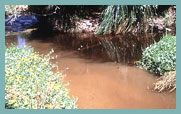CURRENT RESEARCH PROGRAMS
Program 2: Land-use Impacts on Rivers
 Program
Projects Program
Projects
 Click
here for the current list of Projects for this Program
(2003-2006) Click
here for the current list of Projects for this Program
(2003-2006)
 Click
here for completed Projects and their outcomes for this
Program (1999-2002) Click
here for completed Projects and their outcomes for this
Program (1999-2002)
Program
Overview
Detailed Information about current projects in
this program is available here
This program provides a better understanding
of the effects of land use on catchment water balance
and pollutant delivery to streams. Currently, considerable
national investment is being directed towards salinity
and nutrient management strategies and afforestation
programs, despite a relatively poor knowledge of their
efficacy or how they might impact on downstream users.
For instance, broad-scale afforestation is being considered
for recharge control, but the consequent water-yield
decreases may exacerbate the salinity problem downstream.
For large catchments, we need to elucidate the role
of pollutant stores and the manner in which pollutants
are conveyed from the hillslopes to the channel system.
A critical issue to clarify is the extent to which riparian
vegetation and aquifer management can mediate sediment/pollutant
delivery to channels for a range of catchment physiographies
and stream orders. Preliminary research suggests that
90% of the nutrient flux problem can be solved by better
management of 10% of the land area.
Goals
- Determine the impact of vegetation and land cover
on inter-relationships between catchment water yield,
groundwater recharge, and salt loads and concentrations
in rivers
- Improve our understanding of pollutant delivery
to stream channels, and the effect of riparian vegetation
- Develop cost-effective catchment rehabilitation
measures to improve river water quality.
Activities
- Compare and contrast the water and salt balance
of agricultural and afforested catchments in a variety
of settings, linking upland water balance to lowland
stream salinity
- Track the life cycle of sediments and nutrients
through various catchment systems, ascertaining storages,
transit times, and transformations.
- Develop new knowledge regarding the movement of
nitrogen from catchment to streams
Outcomes
- Identification of catchment ‘hot spots’
that contribute most to land and river degradation,
and strategies to treat them.
- The biophysical understanding of catchment pollutant
dynamics needed to underpin catchment management plans
and major works initiatives such as the National Heritage
Trust Program (NHT)
- Practical field knowledge and new theory to assist
in the development and testing of predictive models.
|
